Cryptocurrency has evolved from a "speculative tool" that was once detached from the mainstream financial system into an indispensable component of the global financial ecosystem.
Author: Zhong Yi, China Financial Forty Forum
Recently, global legislation on stablecoins has accelerated. On May 20, the U.S. Senate passed a procedural vote on the "Guiding and Establishing the National Innovation Act for U.S. Stablecoins" (the "GENIUS Act"). Just a day later, Hong Kong's "Stablecoin Regulation Draft" was officially passed by the Legislative Council of the Special Administrative Region and came into effect on May 30, establishing a licensing system for legal currency stablecoin issuers in Hong Kong. The concept of stablecoins has quickly gained popularity in the market.
In fact, CF40 research pointed out at the beginning of the year that "cryptocurrency is no longer what it used to be." Cryptocurrency has transformed from being associated with "money laundering" and "speculation" to a new asset class that institutional investors are participating in on a large scale, becoming an essential part of the global financial ecosystem. As the cryptocurrency market develops, the regulation of cryptocurrencies by major economies has gradually shifted from early concerns about speculation and illegal activities to a more comprehensive and systematic multi-layered regulatory framework.
Stablecoins, as an important node in the intersection of traditional finance and the crypto ecosystem, have become one of the key directions for global cryptocurrency regulation in recent years. Recent global legislative developments indicate that their strategic position and market scale will continue to rise. Moreover, stablecoins are just one category of cryptocurrency; as an ever-evolving field of innovation, the concept and application of cryptocurrency are continuously expanding.
By revisiting this article, we hope to help readers understand the development history and potential trends of cryptocurrency, deepening their understanding and research of it. This article suggests that the mainstreaming of cryptocurrency is driven by multiple factors, including technological innovation, institutional participation, regulatory evolution, and changes in social perception. Given the multidimensional complexity of cryptocurrency and the rapid development of the market with new concepts emerging constantly, it is urgent for our country to clarify the basic concepts and operational mechanisms of cryptocurrency and to build a systematic research framework to lay the foundation for effective regulation.
- The author of this article is Zhong Yi from the China Financial Forty Forum. The original article "Cryptocurrency is No Longer What It Used to Be" was first published on January 5, 2025, in the "CF40 Research" mini-program. By logging into the "CF40 Research" mini-program, you can further understand the "Main Trends in Global Cryptocurrency Regulatory Policies." This article is copyrighted by the China Financial Forty Forum, and any form of reproduction, copying, or citation without written permission is prohibited. Due to space limitations, references are omitted.
In 2009, Bitcoin (BTC), created by Satoshi Nakamoto, ushered in the era of decentralized digital currency. Although this blockchain-based innovation was controversial in its early days due to its anonymity and other attributes, linking it to speculation and illegal activities, it also demonstrated the potential to revolutionize the financial system.
After 2014, Ethereum introduced smart contracts, expanding the boundaries of blockchain applications, while the rise of professional exchanges improved market infrastructure. The initial coin offering (ICO) wave helped shape regulatory frameworks, and the emergence of stablecoins like Tether (USDT) injected stability into the market.
In 2020, global loose monetary policies prompted institutional investors to reassess and position themselves in the cryptocurrency market. The final approval of Bitcoin spot ETFs in January 2024 broadened mainstream investment channels for cryptocurrencies. Notably, after Donald Trump was elected President of the United States, his campaign promise to "make America the world's cryptocurrency capital" and establish Bitcoin reserves sparked a strong market response, driving Bitcoin prices to soar above $100,000 and attracting widespread global attention and discussion about cryptocurrency.
Today, cryptocurrencies represented by Bitcoin are gradually shedding their early labels as "money laundering tools" and "speculative tools," and their new asset class attributes are beginning to gain recognition in the mainstream market. Federal Reserve Chairman Jerome Powell has likened Bitcoin to "digital gold."
These changes prompt us to think deeply: what transformations has cryptocurrency undergone over the past decade?
Overview of Cryptocurrency
(1) Cryptocurrency has developed into at least three different types with distinct characteristics
Cryptocurrency refers to currency that exists only in digital form, utilizing cryptographic technology to ensure transaction security. Cryptocurrencies typically operate on decentralized networks, using blockchain technology as a public ledger for transactions. They can be categorized based on the issuer into central bank digital currencies (CBDCs) and private cryptocurrencies.
CBDCs are issued and managed by central banks and represent the digital form of a country's legal tender, such as the digital yuan (DCEP) issued by the People's Bank of China. Private cryptocurrencies are issued by non-governmental entities and are not controlled by any central authority; this article mainly focuses on private cryptocurrencies.
Since the birth of Bitcoin in 2009, there are now thousands of cryptocurrencies, with new ones potentially emerging every day. Although these cryptocurrencies are all based on decentralized consensus mechanisms and distributed ledger technology, there are some differences in their specific implementations. Based on their design mechanisms and functions, private cryptocurrencies can be primarily divided into three categories: Store of Value Cryptocurrencies, Utility Tokens, and Stablecoins.
It should be noted that cryptocurrency, as an ever-evolving field of innovation, continuously expands its concepts and applications, so these classification boundaries are not absolute. For example, USDT is both a stablecoin pegged to the U.S. dollar and a token on the Ethereum network, also exhibiting characteristics of a utility token.
Category I: Store of Value Cryptocurrencies, with typical representatives being Bitcoin and Litecoin (LTC). Although these cryptocurrencies were initially designed for peer-to-peer electronic payments, they have increasingly taken on the role of digital value storage. They are characterized by decentralization, trustlessness (transactions are verified by the entire network rather than relying on specific institutions), global circulation, and anonymity.
This type of cryptocurrency typically has a dedicated blockchain that supports only this purpose, without supporting smart contracts or decentralized applications (DApps). They usually adopt a fixed supply cap to maintain scarcity, such as Bitcoin's total supply of approximately 21 million and Litecoin's limit of 84 million. Their prices are entirely determined by market supply and demand and are not pegged to any other assets.
Category II: Utility Tokens, with typical representatives being Ether (ETH) and Solana (SOL). Ethereum is the first blockchain platform to support smart contracts, allowing developers to create and deploy decentralized applications (DApps) and digital assets on its network. This programmable feature greatly expands the application scope of blockchain technology and has given rise to innovative application scenarios such as decentralized finance (DeFi).
Tokens refer to any crypto asset that runs on blockchain platforms like Ethereum. In other words, tokens do not need to establish and maintain their own blockchain network but "parasitize" on main chains like Ethereum, requiring the payment of Ether as a transaction fee (Gas fee) for issuing and transferring tokens.
Based on the specific functions of utility tokens, they can be roughly divided into the following three categories:
First, Infrastructure Tokens. These utility tokens are the native tokens of blockchain platforms that support smart contracts, primarily used to maintain network operations and pay for computational resources.
Ether is the most representative infrastructure token, with use cases including paying network transaction fees, providing an operating environment for decentralized applications, and participating in network validation through staking mechanisms to maintain system security.
Second, Service Tokens. Service tokens are a special type of utility token that allows holders to access specific network services or perform related operations. For example, Basic Attention Token (BAT) is a token based on the Ethereum ERC-20 (the most commonly used token standard on the Ethereum network), used within the Brave browser ecosystem to incentivize users to watch ads, pay for advertising, and tip content creators.
Third, Finance Tokens. Finance tokens have a wide range of application scenarios, including decentralized lending, trading, crowdfunding, etc. Holders typically can participate in project governance and share platform profits. Project parties often limit the total issuance, set lock-up periods, and adopt multi-signature management mechanisms. Binance Coin (BNB) is a typical representative, where BNB holders can receive transaction fee discounts.
Category III: Stablecoins, with typical representatives being USDT and USDC. Stablecoins are a type of cryptocurrency designed to maintain value stability relative to a specific asset or a basket of assets. The main difference from Bitcoin is that stablecoins need to be pegged to other assets, with the issuing institution increasing or decreasing supply based on market demand. They can be primarily divided into the following four categories.
First, fiat-backed stablecoins, which are currently the most popular type of stablecoin, are supported by reserves of fiat currency (such as the U.S. dollar, euro, etc.) at a 1:1 ratio, similar to a currency board system, such as USDT and USDC pegged to the U.S. dollar.
Second, commodity-backed stablecoins, which are pegged to the value of physical assets such as gold, silver, or other tangible commodities. For example, PAX Gold is a stablecoin backed by gold reserves, with each token representing one troy ounce of gold stored in a secure vault.
Third, cryptocurrency-backed stablecoins, such as DAI and LUSD, which typically use over-collateralization to mitigate the inherent volatility of their underlying assets. For instance, to obtain $100 worth of DAI, a user needs to collateralize $150 worth of Ether (150% collateralization rate).
Fourth, algorithmic stablecoins, which theoretically can maintain price stability by automatically adjusting token supply and demand through smart contracts without relying on collateral. However, in reality, several projects have failed. Eichengreen (2018) pointed out that "algorithmic central banks" have inherent instability, which was also validated in the 2022 Terra/LUNA collapse.
In addition to the three types of cryptocurrencies mentioned above, blockchain technology has some expansive applications. For example, Non-Fungible Tokens (NFTs) represent digital certificates of an asset on the blockchain, with each NFT having a unique identifier, being indivisible and irreplaceable.
NFTs are currently mainly used in digital art trading (such as digital paintings, music, videos), virtual real estate (such as virtual plots in the metaverse), game items (such as special equipment and characters in games), and digital collectibles (such as sports event memorabilia).
For instance, in March 2021, digital artist Beeple's work Everydays: The First 5000 Days sold for $69.346 million (approximately 450 million RMB) at a Christie's auction, becoming a landmark event in the NFT market.
Additionally, there are some derivative assets based on cryptocurrency, such as Bitcoin futures, Bitcoin futures ETFs, and Bitcoin spot ETFs.
(2) The cryptocurrency market has built a unique financial innovation ecosystem
First, the market capitalization and trading volume of cryptocurrencies have experienced significant growth over the past decade.
As of December 28, 2024, the CoinGecko website has recorded 16,022 cryptocurrencies across 1,200 exchanges worldwide, with a total market capitalization of approximately $3.43 trillion and a trading volume of about $165.3 billion in the past 24 hours.
In relative terms, this market capitalization is equivalent to 5% of the total market capitalization of the U.S. stock market and 35% of the Chinese stock market. In early 2014, the total market capitalization of cryptocurrencies was only $10.6 billion, indicating a growth of over 300 times in the cryptocurrency market over the past decade.

Data Source: CoinGecko, as of December 28, 2024
Second, the diversification of cryptocurrency development continues, with Bitcoin's market capitalization still dominating. As of December 28, 2024, the top three cryptocurrencies by market capitalization are Bitcoin, Ethereum, and USDT, with market capitalizations of $1.87 trillion, $403.3 billion, and $138.6 billion, respectively, accounting for approximately 54%, 12%, and 4% of the total cryptocurrency market capitalization.
Over the past decade, the cryptocurrency market has transitioned from being dominated by Bitcoin to a more diversified landscape. Before 2017, Bitcoin held an absolute dominance, accounting for over 75% of the total cryptocurrency market capitalization. Between 2017 and 2018, with the rise of the Ethereum smart contract platform, Ethereum's market share peaked at around 31%, while Bitcoin's share dropped to a historical low of about 33%.
Bitcoin's market capitalization rebounded thereafter, rising to around 70% in 2020 and currently maintaining a level above 50%, continuing to hold a dominant position. Additionally, the market share of stablecoins (USDT and USDC) has risen from zero to 5%-7%, while emerging cryptocurrencies like BNB and SOL have also captured a certain market share.
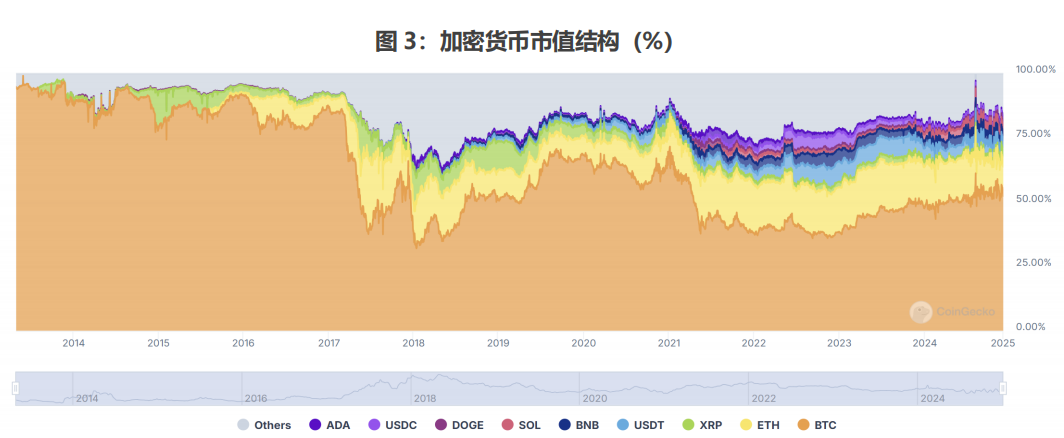
Data Source: CoinGecko, as of December 28, 2024
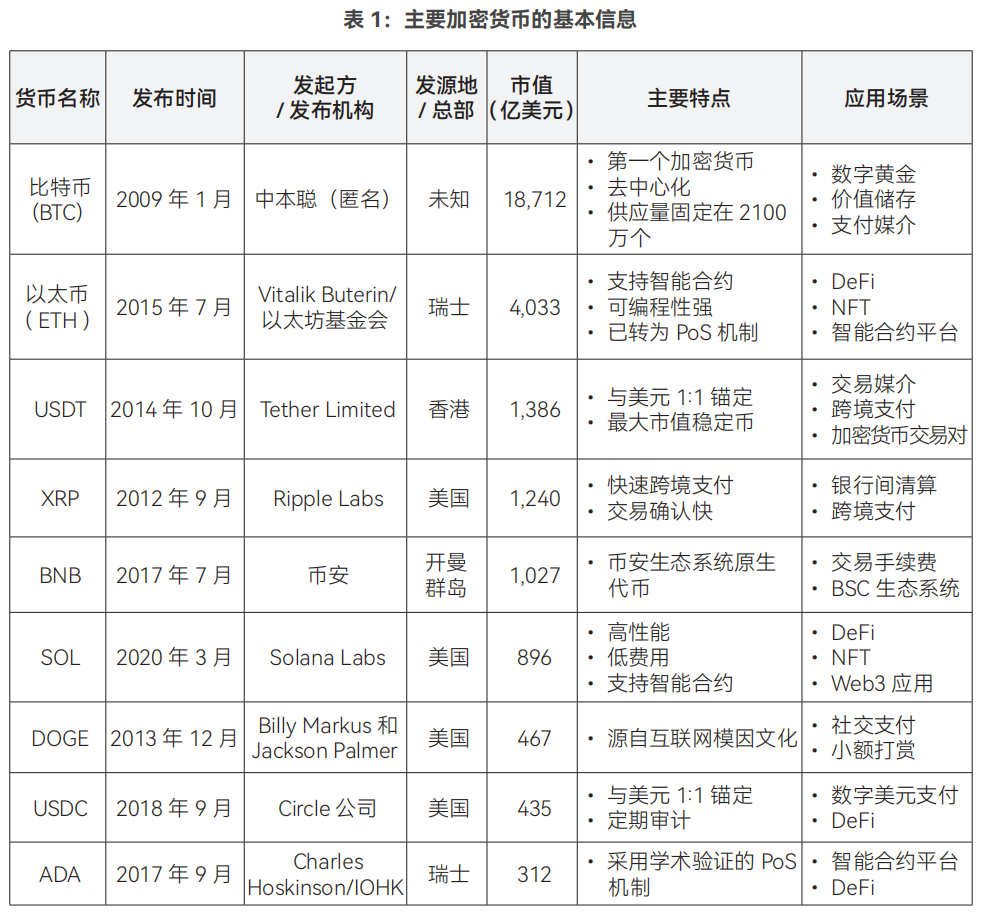
Data Source: CoinGecko, as of December 28, 2024, compiled by the author
Third, since 2022, the trading volume of stablecoins has begun to dominate the cryptocurrency market.
First, the market capitalization of stablecoins has steadily increased. Stablecoins developed relatively slowly before 2019 but experienced explosive growth after 2020. As of December 2024, the total market capitalization of stablecoins reached $211 billion, accounting for 6.12% of the total cryptocurrency market capitalization.
Among them, USDT holds a dominant position in the stablecoin market with a market capitalization of $138.6 billion, accounting for 69%, while USDC ranks second with a market capitalization of $42.5 billion, accounting for 22%. The two major stablecoins together account for over 90% of the market share, showing a highly concentrated pattern (Figure 4).
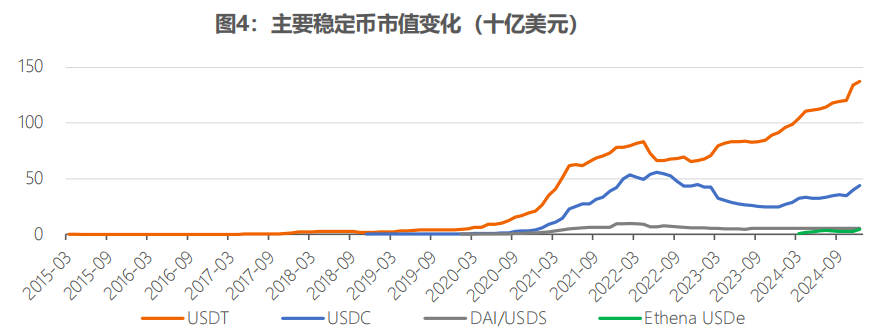
Data Source: CoinMarketCap, as of December 31, 2024
Second, the application scenarios for stablecoins are gradually expanding. In recent months, stablecoins, with a market capitalization of 5%-7%, have accounted for about two-thirds of the total trading volume in the cryptocurrency market (Figure 5). It is noteworthy that these transactions may primarily reflect asset trading rather than everyday consumer payments.
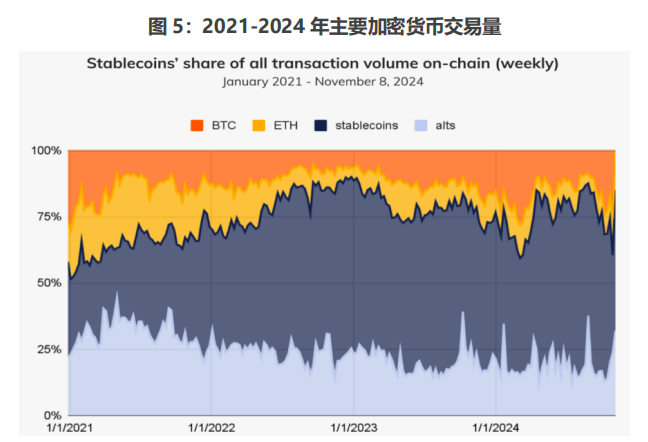
Data Source: Chainalysis
Fourth, Decentralized Finance (DeFi) is showing a volatile upward trend (Figure 6). DeFi provides financial services similar to those of traditional financial systems while achieving financial disintermediation (Table 2). As of December 28, 2024, the market capitalization of DeFi reached $122.7 billion, accounting for approximately 3.6% of the total cryptocurrency market capitalization.
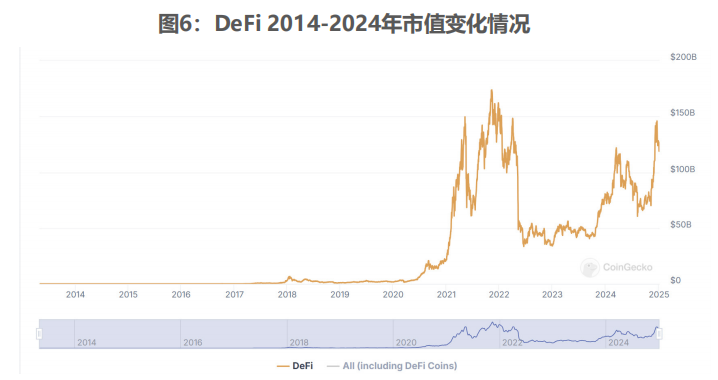
Data Source: CoinGecko, as of December 28, 2024
In the early days (2017-2019), DeFi applications were relatively simple, mainly focusing on lending protocols and stablecoins; in 2020, driven by the concept of "liquidity mining," projects like Uniswap rapidly emerged; around 2021, due to congestion on the Ethereum network, some projects began migrating to emerging high-performance, low-cost public chains like Solana; in 2022, the collapse of the Terra/LUNA ecosystem led to a significant drop in the market capitalization of DeFi, and the industry entered an adjustment period, with the market beginning to stabilize and recover in 2023.
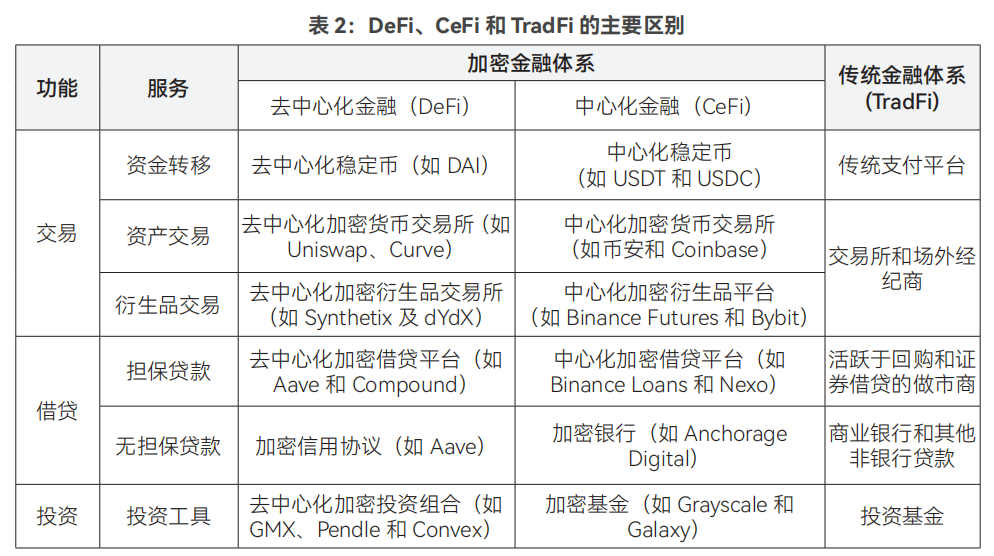
Data Source: IMF, updated examples based on the original text
Fifth, the price trends of cryptocurrencies show distinct characteristics. First, the prices of stablecoins USDT and USDC have largely stabilized around $1 since 2021 (Figures 7 and 8).
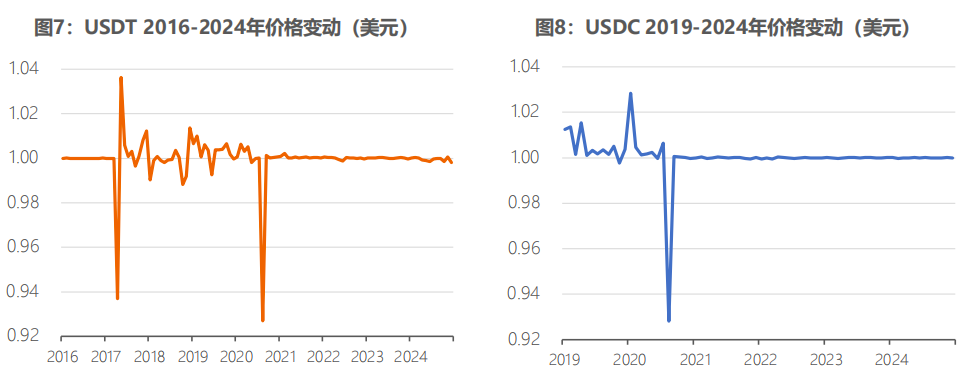
Data Source: CoinMarketCap
The two major stablecoins experienced multiple price fluctuations before 2021: starting in 2017, Tether, the issuer of USDT, faced scrutiny over its dollar reserves due to banking disputes involving its associated company Bitfinex, leading to legal investigations; in 2020, the COVID-19 pandemic caused panic selling in the cryptocurrency market, resulting in both coins losing their peg; after 2021, with the issuer enhancing reserve transparency and market mechanisms improving, prices stabilized around the $1 level.
Second, the price movements of cryptocurrencies exhibit strong internal correlations (Figure 9). The price trends of Bitcoin and Ethereum are highly correlated, with their rises and falls often driving the overall cryptocurrency market's movements. Moreover, they are influenced by various factors, including the global monetary policy environment, regulatory policies, significant industry events (such as the 2022 bankruptcy of the FTX exchange), and inflation expectations.
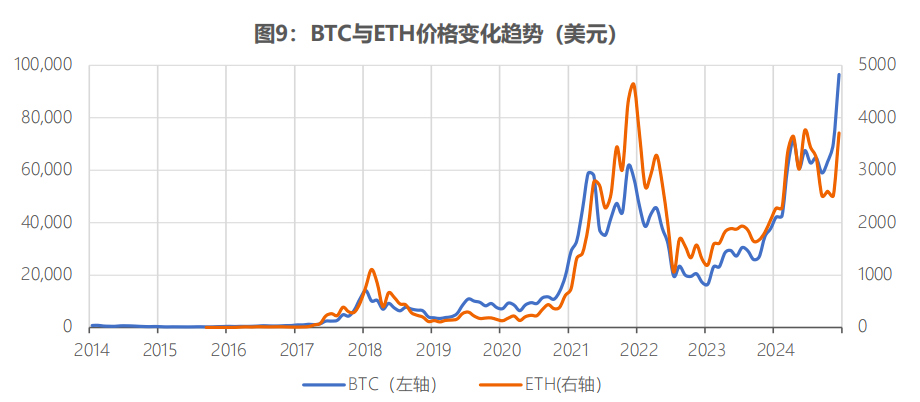
Data Source: CoinGecko
Third, the price volatility of cryptocurrencies is higher than that of traditional financial assets (Figure 10). Comparing the daily volatility of various asset prices: in 2023, Bitcoin's daily volatility was 2.27%, which is 3.4 times that of traditional safe-haven asset gold (0.68%) and 2.5 times that of traditional risk asset the Nasdaq Composite Index (0.91%). In 2024, the volatility of various assets increased, with Bitcoin's volatility rising to 2.76%, which is 3.7 times that of gold (0.74%) and 3.0 times that of the Nasdaq Composite Index (0.93%).
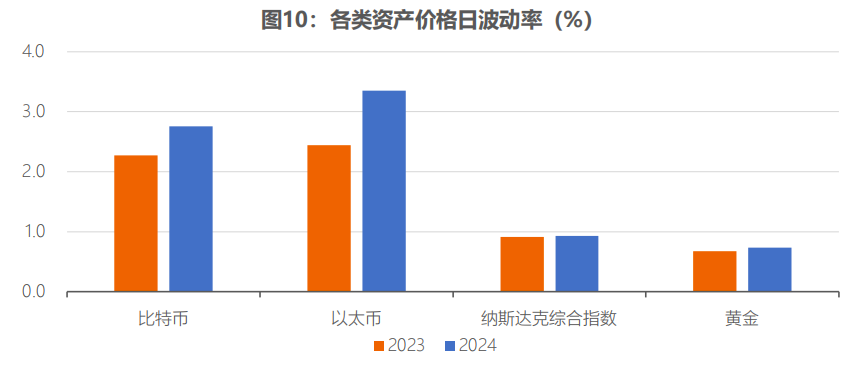
Data Source: CoinGecko, WIND, calculations by the author
Development Trajectory of the Cryptocurrency Market
The development trajectory of the cryptocurrency market is shaped by multiple factors, including institutional participation, regulatory evolution, changes in social perception, and technological innovation.
(1) Early Development (2009-2016): Technological development is in its infancy, traditional financial institutions generally hold negative and cautious attitudes, and regulatory focus is on illegal activities
In 2009, Bitcoin was officially issued, initially spreading mainly among geeks and cryptography enthusiasts, who viewed it merely as a technical experiment.
In May 2010, American programmer Laszlo Hanyecz used 10,000 Bitcoins to purchase two pizzas (worth $25, equating to about $0.0025 per Bitcoin), becoming the first real-world application case of Bitcoin.
From 2010 to 2013, cryptocurrency gradually moved from early experimentation into the public eye. First, the market size expanded rapidly. Bitcoin's price first reached $1 in February 2011, and after its first "halving" in November 2012, it continued to rise, reaching $100 in April of the following year and breaking through $1,000 for the first time in November.
Second, continuous technological innovations emerged. In 2012, Peercoin (PPC) innovatively adopted the Proof of Stake (PoS) consensus mechanism, significantly reducing energy consumption, and subsequent blockchain projects like Ethereum adopted improved PoS mechanisms. The Ethereum white paper was also published during this period, introducing the concept of smart contracts.
Third, exploratory beginnings of payment-related commercial applications occurred. The web content management system WordPress announced in November 2012 that it would begin accepting Bitcoin payments, but three years later, it discontinued this payment option, with its founder stating that the usage rate of cryptocurrencies was too low and that their creation was more philosophical than commercial. In October 2013, Canada established its first Bitcoin ATM, facilitating the exchange of Canadian dollars for Bitcoin.
Fourth, infrastructure such as exchanges began to be established. For a long time after Bitcoin's birth, there were no exchanges, and people mainly traded Bitcoin on the Bitcoin Talk forum. In October 2009, New Liberty Standard began publishing Bitcoin prices calculated based on electricity consumption, with the first quote being $1 for 1,309.03 Bitcoins. In July 2010, the first mainstream trading platform, Mt. Gox, went online, handling about 70% of the trading volume at the time, followed by the establishment of cryptocurrency exchanges like OKCoin, Huobi, and Coinbase.
From 2014 to 2016, the cryptocurrency market entered a brief adjustment period. First, security issues related to technology drew widespread attention. In February 2014, Mt. Gox, then the world's largest Bitcoin exchange, declared bankruptcy due to a hacker attack, losing over 850,000 Bitcoins. Bitcoin's price fell from over $1,000 in December 2013 to below $200 in January 2015.
Second, technological innovation continues to advance. On one hand, the Ethereum mainnet officially launched in August 2015, marking the beginning of the smart contract era. The birth of smart contracts allowed the application of cryptocurrencies to extend beyond simple transfer tools, enabling them to operate automatically according to predefined rules, laying the foundation for the subsequent development of DeFi. On the other hand, Bitcoin experienced its second halving in July 2016, leading to increasingly intense discussions about how to "scale" (allow the network to handle more transactions).
In the early stages of development, traditional financial institutions actively embraced blockchain technology but generally held a cautious and negative attitude towards cryptocurrencies. Institutions tended to discuss blockchain technology separately from cryptocurrencies, reflecting an attitude of embracing technology while being cautious about assets.
JPMorgan CEO Jamie Dimon called Bitcoin a terrible investment, and BlackRock CEO Larry Fink referred to Bitcoin as a "money laundering tool" in 2017, representing the prevailing view in mainstream U.S. finance at the time.
However, starting in 2015, these traditional financial institutions began to pay attention to and experiment with blockchain technology. In 2015, the Nasdaq Stock Exchange launched Linq, a private equity trading platform based on blockchain technology, allowing companies to privately issue "digitalized" equity to investors. The R3 blockchain consortium was established, attracting around 50 major financial institutions globally, including Morgan Stanley and Goldman Sachs, and various blockchain-based innovative projects continued to emerge.
Lael Brainard, a member of the Federal Reserve Board, stated at a 2016 meeting organized by the Institute of International Finance (IIF) that the Federal Reserve had a 300-person team specifically responsible for researching and following up on blockchain technology, keeping pace with market developments.
From 2013 to 2016, countries focused on risks such as speculation, anti-money laundering, counter-terrorism financing, and transaction security, establishing preliminary regulatory frameworks.
The U.S. focused on issues such as speculation and consumer protection. The Financial Crimes Enforcement Network (FinCEN) issued cryptocurrency regulatory guidelines as early as 2013, defining it as "a medium of exchange" and requiring exchanges to perform Know Your Customer (KYC) due diligence and register as Money Services Businesses (MSBs). The Internal Revenue Service (IRS) defined cryptocurrencies as property rather than currency in a 2014 notice, applying capital gains tax rules; the Commodity Futures Trading Commission (CFTC) classified cryptocurrencies as commodities and regulated market manipulation and fraud under the Commodity Exchange Act (CEA); New York State introduced the BitLicense regulatory framework in 2015, requiring businesses to obtain a license to operate within the state. Japan recognized cryptocurrencies as a legal means of payment.
In May 2016, Japan's Financial Services Agency (FSA) added a chapter on "digital currencies" to the Payment Services Act, officially recognizing them as legal means of payment and providing legal protection for digital currency exchanges. As a supporting regulation, the Japanese government also announced the Implementation Order of the Fund Settlement Act on March 24, 2017, detailing regulations on fund transfers and settlements.
In Europe, the European Banking Authority (EBA) issued a report in 2013 warning that Bitcoin might pose risks such as exchange platform collapses leading to withdrawal issues, hacking attacks, and price volatility. In 2016, the European Commission began proposing to include cryptocurrencies and their trading platforms under the Anti-Money Laundering/Counter-Terrorism Financing Directive (AMLD4). After two years of in-depth discussions, the EU officially released the fifth version of the Anti-Money Laundering/Counter-Terrorism Financing Directive (AMLD5) in June 2018, incorporating cryptocurrencies into the regulatory framework for the first time.
(2) ICO Bubble Period (2017-2018): The ICO boom drove cryptocurrency development, with significant fundraising and fraud coexisting, leading to strong regulation.
Cryptocurrencies experienced a brief bull market from 2017 to 2018 (Figure 11), reaching a peak market capitalization in 2018, primarily driven by the ICO boom.
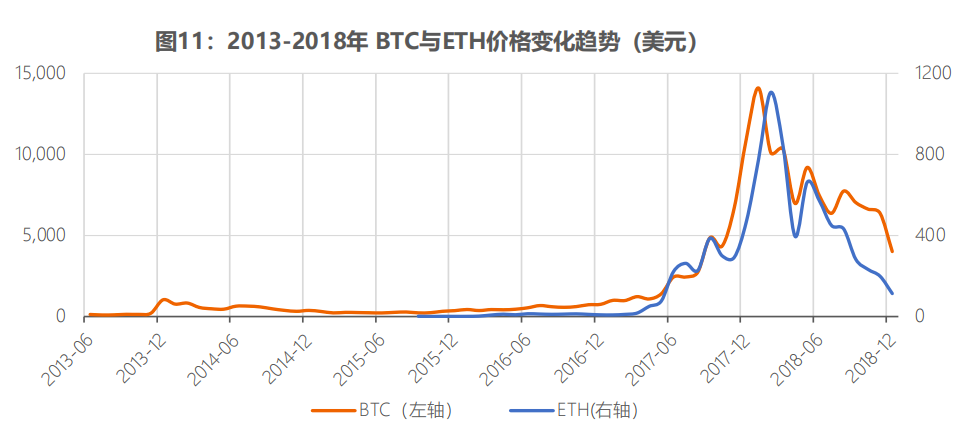
Data Source: CoinGecko
Initial Coin Offerings (ICOs) emerged as an innovative fundraising mechanism in the cryptocurrency space, where project teams issue new cryptocurrencies on the blockchain to raise liquidity in established cryptocurrencies (Bitcoin, Ethereum).
Mastercoin attempted the first ICO in 2013, and Ethereum's ICO successfully raised $18 million in 2014, garnering widespread attention. As Ethereum became the primary ICO issuance platform, its price also rose, leading to increased media discussion about cryptocurrencies, with "blockchain" becoming a buzzword that attracted many retail investors to the market.
However, due to a lack of regulation, heightened speculative sentiment, and technical vulnerabilities, the ICO bubble ultimately burst in 2018. As early as May 2016, the Ethereum-based project The DAO raised approximately $152.3 million through an ICO but suffered a hack a month later due to a smart contract vulnerability, resulting in a loss of about 3.6 million Ether. The failure of numerous low-quality projects and frequent fraudulent activities led to ICOs being viewed as synonymous with "Ponzi schemes."
According to U.S. cybersecurity firm CipherTrace, losses due to ICO exit scams, fake transactions, hacking attacks, and Ponzi schemes reached as high as $750 million in 2018. The Russian Association of Cryptocurrency and Blockchain (RACIB) reported that Russia attracted $300 million in ICO funding in 2017, but half of that was attributed to Ponzi schemes.
Countries strengthened their reassessment of cryptocurrencies and began regulating ICOs. In April 2017, the People's Bank of China and six other departments jointly issued a notice requiring all token issuance fundraising activities to cease immediately and arranged for the return of funds. In July 2017, the U.S. Securities and Exchange Commission (SEC) issued a statement emphasizing the need for enhanced compliance management for ICOs, using The DAO project as an example. The SEC clarified that some ICOs might constitute securities offerings and must comply with relevant regulations, warning of the high risks of fraud and market manipulation associated with ICOs, and advised investors to be wary of false promises of high returns with low risks, particularly regarding unregistered or unlicensed operations. Additionally, the SEC suspended trading for several problematic ICOs, including CIAO and First Bitcoin Capital. Under the dual pressure of project quality and regulation, this round of speculation ultimately ended with the withdrawal of speculative funds and a significant market correction.
At this stage, cryptocurrencies were not frequently used as payment tools and were often associated with illegal activities. Athey et al. (2016) found that by mid-2015, the active use of Bitcoin was not growing rapidly, meaning that there were not many users who frequently used Bitcoin for everyday payments; most Bitcoins were held as investment assets.
Foley et al. (2019) found that from January 2009 to April 2017, illegal activities accounted for a significant proportion of Bitcoin users and transaction activities, with about one-quarter of users (26%) and nearly half of Bitcoin transactions (46%) related to illegal activities; when calculated by transaction amount, about one-fifth (23%) of the total transaction volume and about half (49%) of Bitcoin holdings were associated with illegal activities.
According to their estimates, by April 2017, approximately 27 million Bitcoin market participants primarily used Bitcoin for illegal purposes, collectively holding $7 billion worth of Bitcoin and conducting about 37 million transactions annually, valued at approximately $76 billion.
As an asset, cryptocurrencies had little correlation with traditional financial assets and were mainly driven by their own and market uncertainties. Bianchi (2020) analyzed trading data for 14 major cryptocurrencies between April 2016 and September 2017 and found that the returns of cryptocurrencies had no significant correlation with stock and bond markets; the trading volume of cryptocurrencies was primarily driven by historical price trends and market uncertainties.
At the end of 2017, the Chicago Board Options Exchange (CBOE) and the Chicago Mercantile Exchange (CME) successively launched Bitcoin futures contracts, settled in U.S. dollars, which helped enhance Bitcoin trading activity and achieve price discovery.
(3) Institutional Investment Period (2019-2021): In the context of global liquidity excess, some institutional investors began to incorporate cryptocurrencies into their investment portfolios.
In fact, as early as around 2018, the attitudes of institutional investors began to show subtle changes.
Fidelity established its subsidiary, Fidelity Digital Assets, in 2018, preparing to offer digital asset custody and trading services for institutional investors. In 2019, JPMorgan launched its digital currency, JPM Coin, for instant settlement of payment transactions between clients (though its CEO Jamie Dimon continued to criticize Bitcoin through 2024).
The fundamental shift in institutional investors' attitudes began in 2020, as more traditional financial institutions started to provide positive evaluations of cryptocurrencies and began strategic positioning.
First, the global quantitative easing policies triggered by the COVID-19 pandemic intensified inflation concerns, prompting institutional investors to seek new hedging tools. Bitcoin's price gradually recovered from the $3,800 low during the "Black Thursday" in March 2020, breaking through $20,000 by the end of 2020. During this phase, institutional-level infrastructure for custody, trading, and settlement gradually improved, and industry compliance and security increased, laying the groundwork for subsequent institutional investor market entry.
Second, institutional investors shifted from outright denial to cautious participation, continuously deepening their involvement. In May 2020, renowned investor Paul Tudor Jones announced that he would use Bitcoin as a hedge against inflation. Investment giants like BlackRock began to establish cryptocurrency asset businesses, with BlackRock CEO Larry Fink changing his view on Bitcoin from "money laundering tool" in 2017 to "global asset"; in March 2021, Morgan Stanley became the first major U.S. bank to offer Bitcoin fund investment channels to its high-net-worth clients, managing $4 trillion in client assets, followed closely by Goldman Sachs, which also announced it would provide cryptocurrency investment options for high-net-worth clients.
Payment giants began to integrate into the cryptocurrency ecosystem, with PayPal announcing in October 2020 that it would support users in buying, holding, and selling cryptocurrencies, and expanding services to Venmo users in early the following year; digital payment company Square not only supported cryptocurrency services in its Cash App but also purchased $50 million worth of Bitcoin as reserve assets; in March 2021, payment platform Visa announced it would allow the use of cryptocurrencies to settle transactions on its payment network.
Publicly traded companies, represented by MicroStrategy, began to allocate Bitcoin, with the company purchasing $250 million worth of Bitcoin in August 2020 and subsequently increasing its holdings multiple times, financing Bitcoin purchases through convertible bonds and stock offerings; as of December 15, 2024, it had accumulated approximately 439,000 Bitcoins; Tesla also announced in early 2021 that it had purchased $1.5 billion worth of Bitcoin.
Third, the regulatory policy framework is becoming increasingly clear, promoting the mainstreaming of the cryptocurrency industry. In 2020, the Office of the Comptroller of the Currency (OCC) in the United States issued guidance allowing federal banks and savings associations to provide custody services for crypto assets. This move lowered the technical barriers and risks for individual users to store digital assets, while also opening new business directions for traditional financial institutions. It is expected that the four major banks—BNY Mellon, State Street, JPMorgan, and Citigroup—will begin offering crypto asset custody services by 2025, collectively managing over $12 trillion in assets.
The Commodity Futures Trading Commission (CFTC) views cryptocurrencies as commodities and is responsible for approving new cryptocurrency derivatives. The SEC maintains a strict regulatory stance on cryptocurrencies, continuing to crack down on multiple ICO projects on the grounds of "unregistered securities," such as the forced shutdown of Telegram's TON project, which resulted in a $18.5 million settlement.
Additionally, in September 2020, the European Union proposed the Markets in Crypto-Assets (MiCA) draft legislation, aimed at establishing a unified regulatory framework for crypto assets among member states.
(4) Structural Transformation (2022): Major risk events trigger deep adjustments in the cryptocurrency market
First, the market experienced a deep correction after reaching historical highs. Bitcoin's price surged from $30,000 at the beginning of 2021 to nearly $68,000 in November, driven by institutional allocations and retail investments, while Ethereum also surpassed $4,800. However, in 2022, influenced by factors such as the Federal Reserve's interest rate hikes, the collapse of Terra/LUNA, and the bankruptcy of the FTX exchange, Bitcoin fell to a low of $16,000.
Second, the outbreak of risks prompted the cryptocurrency industry to reassess systemic risk management. In May 2022, the Terra LUNA ecosystem collapsed, with its native token LUNA plummeting from a high of $119 in early April 2022 to nearly zero within days, while its algorithmic stablecoin UST severely depegged, leading to a total market value evaporation of over $40 billion. This event exposed fundamental flaws in algorithmic stablecoins, such as excessive reliance on market confidence and lack of sufficient external reserves.
This collapse significantly impacted the cryptocurrency market, causing notable declines in the prices of mainstream cryptocurrencies like Bitcoin and Ethereum, and triggering a series of chain reactions. The well-known cryptocurrency hedge fund Three Arrows Capital (3AC) went bankrupt due to heavy leverage used in investing in LUNA and other cryptocurrencies, owing over a billion dollars to institutions including Voyager Digital and Genesis Trading; the centralized lending platform Celsius froze user withdrawals and declared bankruptcy in June 2022, revealing a balance sheet gap of up to $1.2 billion; Voyager Digital also filed for bankruptcy protection due to 3AC's default.
The crisis peaked in November 2022 when the world's second-largest cryptocurrency exchange, FTX, and its affiliated company, Alameda Research, were exposed for serious financial issues, including misappropriation of customer funds and using their own issued FTT tokens as primary loan collateral. The exposure of these issues triggered market panic, causing FTX's valuation to plummet from $32 billion to bankruptcy within a week.
These events revealed flaws in centralized institutions regarding risk management, fund segregation, and corporate governance, including excessive leverage, maturity mismatches, and lack of internal controls.
Third, market turmoil led to a divergence in institutional investor participation in the cryptocurrency market. Some institutions chose to scale back their operations, with Tesla selling 75% of its Bitcoin holdings (approximately $936 million) in the second quarter of 2022, citing the need to maintain liquidity; several banks paused or reduced cryptocurrency-related services following the FTX incident.
On the other hand, some institutions that view cryptocurrencies as a long-term strategic layout continued to invest. MicroStrategy continued to increase its Bitcoin holdings during the market downturn; Fidelity Digital Assets officially began offering Ethereum purchase, sale, and transfer services for institutional clients at the end of October 2022.
Fourth, the technological foundation continued to solidify, and key technological upgrades progressed as planned. In September 2022, Ethereum successfully completed the "Merge" upgrade, transitioning its consensus mechanism from Proof of Work (PoW) to Proof of Stake (PoS). This upgrade reduced the energy consumption of the Ethereum network by over 99.9%, shifting block production from energy-intensive mining to a staking-based validation mechanism. After the upgrade, the number of Ethereum validators and staking demand increased, reflecting the community's confidence in the Proof of Stake (PoS) mechanism.
Ethereum's Layer 2 scaling networks made significant progress, with major projects like Arbitrum and Optimism processing transactions on the mainnet, reducing user costs and enhancing network performance. Additionally, with improvements in cross-chain bridge security, the establishment of decentralized identity (DID) standards, and the development of privacy protection technologies like zero-knowledge proofs, the Web3 infrastructure gradually improved.
Fifth, industry events accelerated the regulatory legislative process. Japan began discussing stablecoin regulation as early as 2019, and after the Terra/LUNA incident in May 2022, Japan expedited its legislative process, passing amendments to the Fund Settlement Act in June 2022 to comprehensively regulate the issuance, circulation, and redemption of stablecoins. The EU officially passed the MiCA legislation in 2022, marking the world's first comprehensive regulatory framework for crypto assets, covering issuance standards, service provider regulations, and market conduct supervision.
(5) Steady Development Period (2023-2024): The market stabilizes, the regulatory framework takes shape, and the approval of Bitcoin spot ETFs expands participation channels in the crypto market
First, the market gradually recovered after experiencing significant risk events. The negative impacts of events like the FTX bankruptcy in 2022 gradually faded, with Bitcoin's price steadily rising from $16,000 at the end of 2022, surpassing $70,000 in March 2024. The market structure further optimized, with increased transparency in centralized exchanges (CEX). To restore market trust and meet regulatory requirements, many centralized exchanges (such as Binance and Coinbase) began implementing more transparent asset proof mechanisms (Proof of Reserves) to ensure that user assets are properly managed and verified; at the same time, the development of decentralized exchanges (such as Uniswap and SushiSwap) provided more diversified trading options for the market.
Second, the application and infrastructure of the cryptocurrency industry continued to develop, with accelerated technological innovation. Ethereum's Layer 2 ecosystem (such as Polygon, Arbitrum, and Optimism) continued to grow; NFT technology saw ongoing innovative applications in brand marketing, gaming, and art; blockchain infrastructure began integrating AI functionalities, such as smart contract automation and risk control; the Bitcoin network is attempting to transition from a static chain to a multifunctional ecosystem; new application forms like decentralized social networks (DeSoc) began to emerge; and decentralized physical infrastructure networks (DePIN) also experienced significant growth in 2024, with a total market value exceeding $40 billion, a year-on-year increase of 132%. DePIN is making its mark in globally significant industries such as telecommunications, mobile communications, and energy, injecting new vitality and possibilities into the transformation of these traditional sectors.
Third, the cryptocurrency regulatory framework further improved, and Bitcoin officially entered the mainstream investment arena. The U.S. Securities and Exchange Commission (SEC) underwent a shift from strict restrictions to gradual acceptance—transitioning from stringent regulation of ICOs in 2017, multiple rejections of Bitcoin ETF applications in 2019, to the approval of Bitcoin futures ETFs in 2021, and finally, in early January 2024, approving Bitcoin spot ETF applications from 11 institutions, including BlackRock and Fidelity, providing a compliant channel for institutional investors to participate. The EU also officially implemented the MiCA legislation starting in 2023. Hong Kong also introduced a new licensing system for virtual asset service providers (VASP) and allowed retail investors to trade ETFs and other products.
Fourth, traditional financial institutions entered the market on a large scale, accelerating the integration of crypto finance with traditional finance. First, traditional investment institutions actively expanded cryptocurrency investment channels. In June 2023, BlackRock began applying to the SEC for a spot Bitcoin ETF, with other large financial institutions following suit, ultimately receiving approval in January of the following year. According to a report by Messari, the influence of cryptocurrency lobbying surged in 2024, with the industry increasing efforts to promote favorable regulations, with total spending reaching $200 million, ranking among the top five lobbying expenditure industries.
Second, the cryptocurrency market witnessed a substantial breakthrough in institutional investment. After the listing of Bitcoin ETFs, performance was strong, with continuous inflows of funds, and the total market size of Bitcoin spot ETFs reached approximately $100 billion in 2024. Among them, the Bitcoin spot ETF (IBIT) launched by BlackRock set a new record in the ETF market, surpassing $3 billion in managed assets in the first month and climbing to $40 billion within 200 days.
Third, traditional financial institutions are laying out in various areas of the cryptocurrency industry, including tokenization of physical assets and stablecoins. Institutions like Sky (formerly MakerDAO) and BlackRock launched on-chain money market funds; Ondo Finance's USDY (tokenized treasury fund) reached a management scale of $440 million; institutions are actively exploring the application potential of blockchain in reducing costs, enhancing transparency, and improving payment efficiency, with PayPal issuing the PYUSD stablecoin on the Solana platform.
Fourth, institutional investors generally hold an optimistic view of cryptocurrencies. According to Fidelity's survey of institutional investors regarding digital asset investments in 2023, 51% of respondents indicated that they have already invested in digital assets, with the core logic being: if digital assets truly become a more mainstream means of value storage in the future, the market space will far exceed the current one. Gold currently has a market value exceeding $18.5 trillion, while Bitcoin's market value has grown from 1.6% of gold's market value in 2020 to nearly 10% by November 2024.
With the emergence of more traditional investment tools like ETFs, institutional investment in digital assets is becoming more convenient, and the pace at which Bitcoin catches up may further accelerate. According to PwC's 2024 survey on hedge fund investments in digital assets, hedge funds are generally increasing their allocations to digital assets, primarily driven by improved regulatory transparency, the introduction of new investment tools (especially ETFs), growing investor interest, and the entry of mainstream institutions.
Fifth, Bitcoin has demonstrated a safe-haven function similar to gold in specific contexts (Figures 12 and 13). After 2020, the relationship between Bitcoin prices, gold prices, and the Nasdaq index underwent significant changes. In the early stages of the COVID-19 pandemic (March-April 2020), all three rebounded after a brief decline, but the pace and intensity of their performances varied: the Nasdaq rebounded strongly first, driven by tech stocks, gold steadily rose due to safe-haven demand, while Bitcoin experienced the most volatility. Subsequently, during the global liquidity easing period (from the second half of 2020 to early 2021), Bitcoin exhibited a significant positive correlation with the Nasdaq, reflecting its characteristics as a risk asset, while gold, after reaching a historical high in August-September 2020, entered a correction phase. During the inflationary period in 2021, this divergence further intensified, with the Nasdaq continuously reaching new highs, Bitcoin experiencing two significant rallies, while gold's performance remained relatively subdued.
After the Federal Reserve initiated the interest rate hike cycle in 2022, both the Nasdaq and Bitcoin experienced significant declines, particularly exacerbated by the FTX incident, while gold demonstrated strong stability due to safe-haven demand. During the regional banking crisis triggered by the collapse of Silicon Valley Bank in 2023, Bitcoin and gold exhibited a strong positive correlation, both rising due to increased safe-haven demand, while the Nasdaq continued its upward trend after short-term volatility. This evolution may indicate that Bitcoin is gradually beginning to exhibit safe-haven characteristics similar to gold in specific market environments, moving away from its earlier status as a highly correlated risk asset with the Nasdaq.
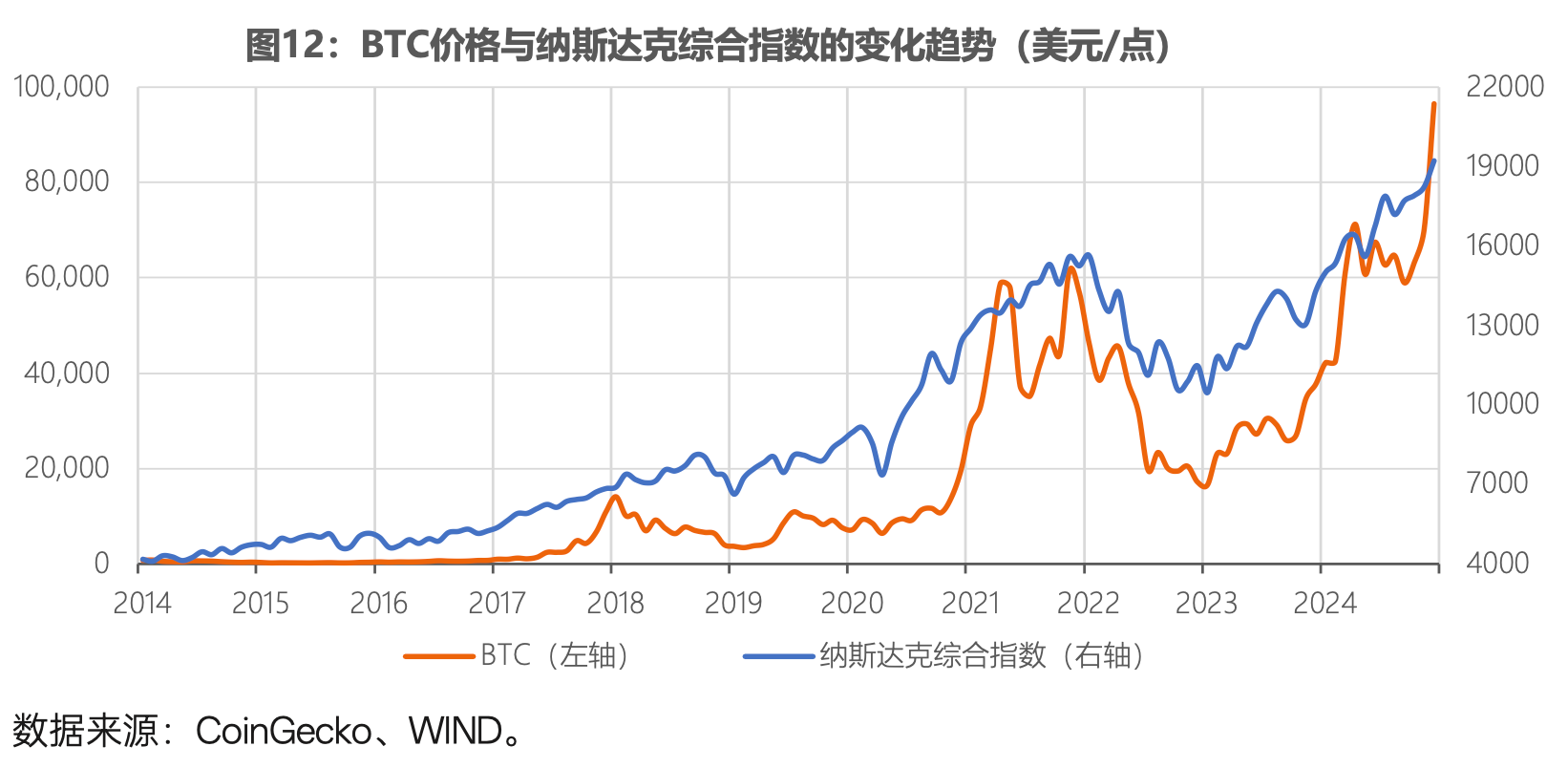
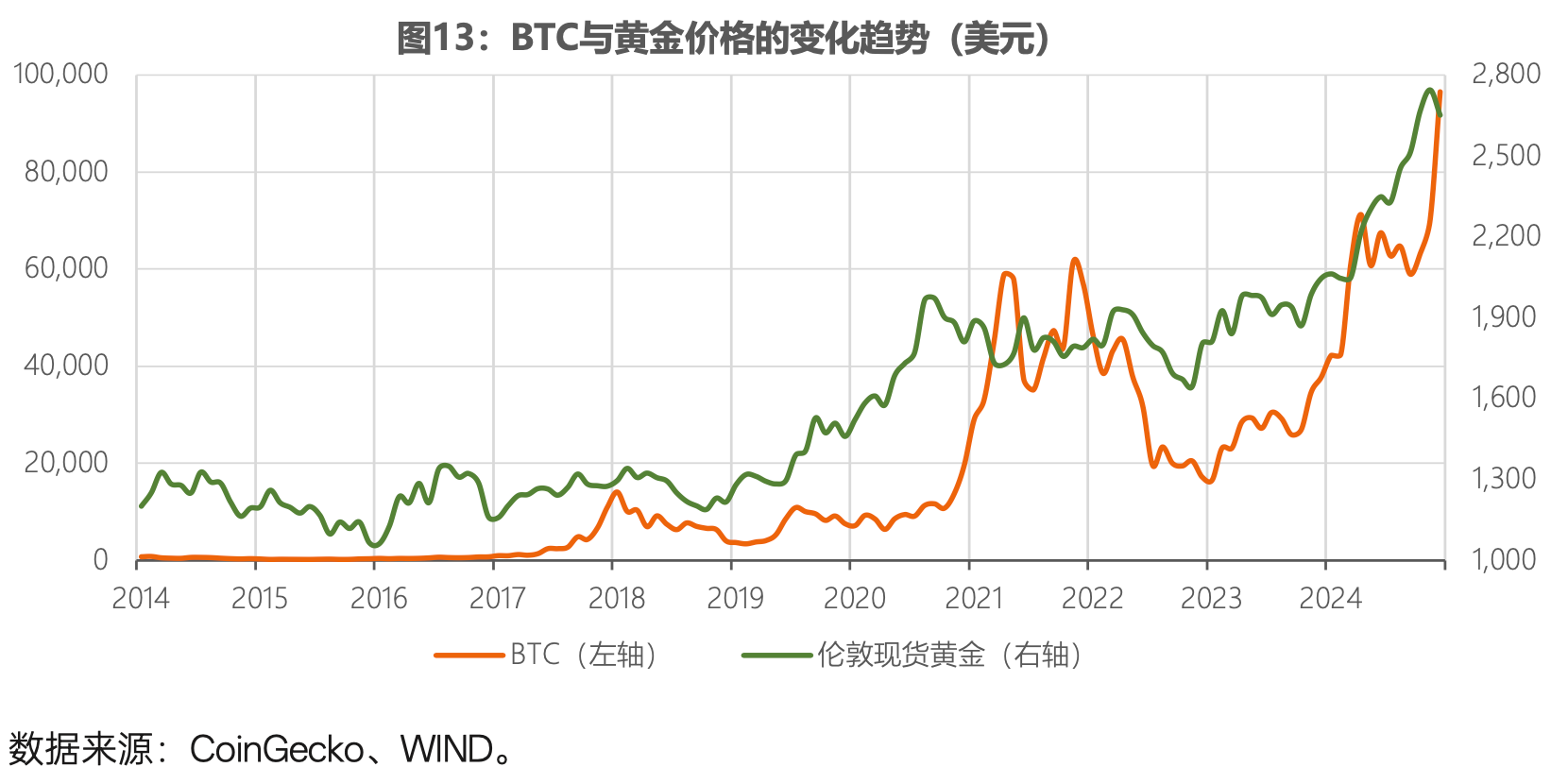
Previous studies have also suggested that Bitcoin possesses risk-hedging capabilities similar to gold (Dyhrberg, 2016) and can serve as an inflation hedge (Blau et al., 2021; Choi and Shin, 2022).
This is also reflected in the views of some institutional investors. BlackRock expressed similar opinions in October 2023 and September 2024, stating that the long-term return drivers of Bitcoin fundamentally differ from those of traditional asset classes, and in some cases, are even opposite. Global investors face challenges from escalating geopolitical tensions, a deepening U.S. debt crisis, and political instability, leading Bitcoin to be viewed as a unique hedging tool against these fiscal, monetary, and geopolitical risk factors. Federal Reserve Chairman Jerome Powell publicly stated in December 2024 that Bitcoin "is like gold, except it is virtual and digital."
Conclusion and Reflections
The cryptocurrency market is undergoing profound changes. Looking at its development trajectory, cryptocurrencies have evolved from a "speculative tool" that existed outside the mainstream financial system to an indispensable component of the global financial ecosystem.
This transformation is both profound and rapid, driven by multiple factors including technological innovation, institutional participation, regulatory evolution, and changes in social perception. Today's cryptocurrency market presents a new face across several key dimensions.
First, cryptocurrencies have transitioned from purely experimental new technologies to a substantial asset class. Currently, the market capitalization of cryptocurrencies has exceeded $3 trillion, which is equivalent to one-third of the market capitalization of China's A-shares, whereas just a decade ago, its scale was only over $10 billion, and Bitcoin was first introduced about fifteen years ago. Among them, Bitcoin has risen from an innovative experimental product that only attracted the attention of tech enthusiasts to become the seventh-largest asset globally, surpassing traditional safe-haven asset silver and energy giant Saudi Aramco.
Second, the cryptocurrency landscape has evolved from being dominated solely by Bitcoin to a diverse crypto ecosystem that continues to evolve. First, there is a vast number of cryptocurrencies. According to CoinGecko, there are over 16,000 cryptocurrencies, and there are 1,200 cryptocurrency exchanges. Second, the crypto ecosystem has built infrastructure corresponding to the traditional financial system (Table 2), enabling core functions such as trading, lending, and investment.
Third, the functionalities of cryptocurrencies have diversified. Early Bitcoin primarily served as a means of value storage and payment. With the emergence of Ethereum and smart contracts in 2014-2015, the application scope of cryptocurrencies has expanded, continuously giving rise to various new applications such as decentralized finance (DeFi), non-fungible tokens (NFTs), decentralized social networks (DeSoc), decentralized physical infrastructure networks (DePIN), and payment finance (PayFi). Stablecoins attempt to address the issue of excessive price volatility in cryptocurrencies while improving payment efficiency and reducing costs. According to research by Visa and Castle Island Ventures, by 2024, the total circulating supply of stablecoins has exceeded $160 billion, compared to only several billion four years ago.
Fourth, there is an increasing overlap and integration between crypto financial services and traditional financial services. Initially, cryptocurrencies like Bitcoin were positioned as decentralized systems independent of current central banks and banking systems, but now the boundaries between some cryptocurrency services and traditional financial services are not clearly defined.
This trend of integration is evident in various aspects: for example, stablecoins pegged to fiat currencies resemble a currency board system, with cryptocurrency prices supported by actual reserves of assets like the U.S. dollar and euro; in 2019, JPMorgan launched its digital currency, JPM Coin, for client settlement payments; starting in 2020, payment giants like PayPal and Visa began supporting cryptocurrency-related payment services; the U.S. allowed banks to provide custody services for crypto assets starting in 2020; and institutions like BlackRock launched on-chain money market funds. The crypto financial system seems to be transitioning from a "competitor" that completely replaces traditional finance to a "collaborator" that promotes integration with traditional finance.
Fifth, the cryptocurrency market is shifting from a retail-driven speculative market to an emerging asset class with significant institutional investor participation, trending towards mainstream acceptance. Initially, large investment institutions generally held a negative view of cryptocurrencies, considering them as "money laundering tools" or "speculative instruments." However, as the prices of Bitcoin and Ethereum rose, global quantitative easing policies exacerbated inflation concerns, prompting institutional investors to seek new hedging tools. Starting in the second half of 2020, investment giants like BlackRock and Fidelity began to enter the crypto asset space, and traditional companies like MicroStrategy also started allocating Bitcoin.
Larry Fink, CEO of BlackRock, represents a microcosm of the broader shift in perspective among large investment institutions regarding cryptocurrencies. Subsequently, these institutions began actively promoting the mainstream acceptance of crypto assets like Bitcoin. After multiple applications and rejections, the U.S. SEC officially allowed 11 institutions, including BlackRock, to launch Bitcoin spot ETFs in January 2024, broadening the pathways for investors to participate in the cryptocurrency market. Stable long-term capital helps reduce market volatility, leading the cryptocurrency market towards maturity.
Sixth, the regulation of cryptocurrencies has evolved from a focus on speculation and illegal activities to exploring the establishment of a multi-layered regulatory framework. Early regulatory efforts concentrated on speculation and illegal activities, gradually developing into a more comprehensive and systematic regulatory framework covering various dimensions such as stablecoin payments, anti-money laundering/anti-terrorist financing, and cross-border transactions. Throughout this evolution, countries' regulatory attitudes and classifications regarding cryptocurrencies have continuously adjusted alongside market developments.
As the global financial center, the shift in the U.S. regulatory stance is representative. Between 2013 and 2016, the Financial Crimes Enforcement Network (FinCEN), the Internal Revenue Service (IRS), and the Commodity Futures Trading Commission (CFTC) successively issued regulatory rules primarily targeting speculative risks and illegal activities. The ICO boom in 2017 prompted the SEC to classify cryptocurrencies under securities regulation, initiating an in-depth game between regulatory agencies and the cryptocurrency market. The approval process for Bitcoin spot ETFs illustrates the SEC's evolving stance, transitioning from strict scrutiny and multiple rejections to a more open and accepting attitude.
From this, the following insights can be drawn:
First, there is a need to systematically construct an understanding and research framework for the cryptocurrency system. Cryptocurrencies involve multiple professional fields, including finance, cryptography, and blockchain technology, and are closely related to core functions of the modern financial system such as payments, trading, and investment. This multidimensional complexity, combined with the rapid development of the market and the emergence of new concepts, makes it difficult to form a clear and unified cognitive framework. Therefore, clarifying the basic concepts and operational mechanisms of cryptocurrencies and building a systematic research framework is an important foundation for effective regulation.
Second, cryptocurrencies should be viewed as an important variable that may impact financial stability. With the rapid growth of the cryptocurrency market and its accelerated integration with traditional financial services, policymakers need to consider the potential impacts on financial stability, just as they would assess factors in traditional financial markets. Particularly for stablecoins, former Federal Reserve Chairman Ben Bernanke viewed them as a form of bank money backed by financial assets and warned that without adequate regulation, stablecoins could face risks of insufficient asset backing, similar to bank runs, potentially triggering a financial crisis.
Third, an increasing number of countries are inclined to establish regulatory rules and legislation to manage cryptocurrencies. According to PwC's 2023 survey of 35 major countries and regions, approximately 90% of the countries and regions in the sample have begun to establish a regulatory framework for cryptocurrencies, covering various aspects such as regulatory frameworks, anti-money laundering/anti-terrorist financing, travel rules, and stablecoin payment usage. Most countries have at least established anti-money laundering/anti-terrorist financing frameworks, which are currently a key area of cryptocurrency regulation.
免责声明:本文章仅代表作者个人观点,不代表本平台的立场和观点。本文章仅供信息分享,不构成对任何人的任何投资建议。用户与作者之间的任何争议,与本平台无关。如网页中刊载的文章或图片涉及侵权,请提供相关的权利证明和身份证明发送邮件到support@aicoin.com,本平台相关工作人员将会进行核查。




